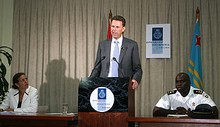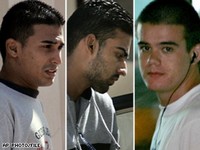Aruba, Just How Much Evidence Do You Need to Actually Prosecute a Case? When is New Evidence not New Evidence, or is the Issue the Judge Reviewing It?
Posted in: Amigoe,Aruba,Corruption,Crime,Deepak Kalpoe,Joran Van der Sloot,Judicial,Murder,Natalee Holloway,NH Statements
When is new evidence not new evidence … when it takes place in Aruba. Is it the evidence that is the issue, or is it the judges that are reviewing the evidence?

One needs to ask the following question of Aruba officials and the Aruban people. What would happen in Aruba if a suspect was tried and convicted of a rape, murder or other violent crime and was serving time in prison only to have new evidence presented in their case because of new technology. Say for instance, new DNA testing that proved 100% that the convicted suspect could never have committed the crime. In Aruba, would that be considered new evidence? Would that new evidence be used to exonerate the suspect and allow the falsely convicted suspect to go free like HERE or HERE. Or would the Aruban legal system say, who cares … you must finish your sentence for a crime that you did not commit?
Now answer that very same question in reverse. What’s the difference when that same new evidence proves that a crime was committed and by who? Would not that be considered new evidence in an investigation? Hmm?
Thus is the situation in the Natalee Holloway investigation where the Aruban prosecutor, Hans Mos, presented new evidence from a suspects computer hard drive that stated, “Natalee Holloway was dead”. Evidence that the prosecutor states was only made newly available through new technology from the Netherlands. How can new evidence gained from new technology not be considered new evidence is the real question. The question then really becomes, is it the evidence that is the issue or the judge reviewing the evidence.
With the newest digital technologies from the Netherlands, the investigation team this time recovered what was impossible earlier. On the hard drive of a confiscated computer was a chat-session, in which one of the suspects said that the missing teenager Natalee Holloway is dead. The OM didn’t say which of the suspects said that, but the information is substantial and especially ‘new’ evidence, and sufficient for the OM to arrest the three. Obtaining information from new technology is also considered new evidence, explained Mos. He compared it with a DNA-investigation that after years, can still give evidence.
Take a good hard look at what this evidence really is folks. A suspect who was last seen with Natalee Holloway before she disappeared forever and said she was dead. This occurred between 5 and 6 hours after Natalee Holloway was last seen with the three suspects. Why would a person who was seen leaving Carlos n’ Charlie’s with Natalee Holloway ever reference the word “dead” if they did not have person knowledge that the Alabama teenager was in fact dead? We have been told all during this case, “if there is no body, there is no crime”. That is utter nonsense, if a suspect references the fact that the person in question is dead … then guess what … that is a complete admission to the fact that she is. Now the question arises, how and why would any of the three suspects make such a claim or even have knowledge of such information? This admission of “death” is long before the story had ever been reported or the TV cameras and media came to Aruba.
In an Internet chat shortly after Holloway vanished, one of the three suspects said she was dead, Mos said.
The chat, retrieved from a computer hard disk, was among new evidence prosecutors used to justify re-arresting the three in November, he said.
New technology that was not available in 2005 was used to find that chat and more between two of the three suspects, as well as others, he said. (CNN)
We will not even get into the fact that the three suspects had an MO and openly bragged on line about what their plans were to do to American girls that they picked up. No premeditation there, huh? Think there were references to the potential use of “date rape” drugs in those chat sessions? Seriously people, how exactly do you think that a person walks out of a bar in less that 1/2 hours with another person that they had never met before? Hmm?
Other chats written before May 30 were also found, in which the suspects discussed “picking up American girls and what they plan to do with them,” Mos said. Such chats gave authorities an idea of how the suspects operated, he said.
Why would one need new technology to create a time line of the declarations? However, what one would need to do is actually look at the declarations and see that the three suspects constantly changed their versions of the story of what happened the night that they were last seen with Natalee Holloway. Even the OM agrees that the last version of the suspects statements are lies.
The new investigation team with Dutch detectives could also use technologies to make a timeline of all the declarations. It appears that the last version of the three suspects on the day that Natalee disappeared is also not correct.
OM gives up core evidence Holloway-case (Amigoe, 12/21/2007)
Chief district attorney Hans Mos explains why the case against the three suspects in the Natalee Holloway-case was dropped.
ORANJESTAD – A chat-session, computer disks, and two new testimonies were among others, the reason for the OM to detain Joran van der Sloot and the brothers Deepak and Satish Kalpoe in November, indicated chief district attorney Hans Mos yesterday in a press conference, where he explained the case that has been dropped.
With the newest digital technologies from the Netherlands, the investigation team this time recovered what was impossible earlier. On the hard drive of a confiscated computer was a chat-session, in which one of the suspects said that the missing teenager Natalee Holloway is dead. The OM didn’t say which of the suspects said that, but the information is substantial and especially ‘new’ evidence, and sufficient for the OM to arrest the three. Obtaining information from new technology is also considered new evidence, explained Mos. He compared it with a DNA-investigation that after years, can still give evidence.
The new investigation team with Dutch detectives could also use technologies to make a timeline of all the declarations. It appears that the last version of the three suspects on the day that Natalee disappeared is also not correct. Other new, indirect evidence are two testimonies. A woman told the team in June of 2005 that five hours after Natalee was seen alive for the last time, she received a telephone call from one of the three former suspects. From his voice she noticed that something was wrong. When she asked him what was wrong, he said that he doesn’t want to compromise her. “I cannot tell you what has happened over the phone”, was his answer.
In a declaration in November of 2006, a witness described the deviant behavior of one of the three one day after the disappearance of Holloway. That was also indirect evidence. The new evidence was for the judge too indirect and not enough to keep the three in custody. But Justice was confident that the three would start talking.
“Information they gave the media gives the impression that they had more things to say than they had told us until now”, said Mos, who said that the conversations the three former suspects had with Dutch journalists were also filed as evidence in the dossier.
With all this evidence that the OM obtained after the three were released at the end of summer in 2005, the judge give them permission to arrest the three. The OM was also in a hurry, due to the European treaty on the suspects’ rights to be tried within a reasonable period of time. The OM has set a deadline for December 31. Mos says that Van der Sloot and Deepak and Satish Kalpoe are still the three most important persons in the investigation, and possible new evidence will be investigated till the term of investigation is over. The police corps in Aruba keeps therefore four detectives available for new information and implication. Term of limitation for culpable homicide is six years and manslaughter is 12 years.
The case will be reopened if necessary. According to Aruban law, it is possible to close the criminal case without bringing it before the court. A definite acquittal can be avoided with this. The former suspects are also protected against ‘repeated troubling for the same facts based on the same evidence’. But the protection is less powerful than acquittal. After an acquittal by a judge in last instance, it won’t be possible to bring the same facts before the court again.

Social Web